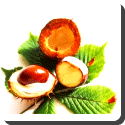 Horse Chestnut — The genus Aesculus comprises 20–25 species of deciduous trees and shrubs native to the temperate northern hemisphere, with 7–10 species native to North America and 13–15 species native in Eurasia; there are also several natural hybrids. They have traditionally been treated in their own usually monogeneric family Hippocastanaceae, but genetic evidence has led to this family, along with the Aceraceae (Maples and Dipteronia), being included in the soapberry family (Sapindaceae).
Horse Chestnut — The genus Aesculus comprises 20–25 species of deciduous trees and shrubs native to the temperate northern hemisphere, with 7–10 species native to North America and 13–15 species native in Eurasia; there are also several natural hybrids. They have traditionally been treated in their own usually monogeneric family Hippocastanaceae, but genetic evidence has led to this family, along with the Aceraceae (Maples and Dipteronia), being included in the soapberry family (Sapindaceae).
The North American species are known as Buckeyes and the Eurasian species as Horse-chestnuts. Some are also called “White Chestnut” or “Red Chestnut” (as in some of the Bach flower remedies. In Britain, they are sometimes called “Conker trees” because of their link with the game of Conkers ).
Aesculus are woody plants from 4 to 36m tall (depending on species), and have stout shoots with resinous, often sticky, buds; opposite, palmately divided leaves, often very large (to 65 cm across in the Japanese Horse-chestnut Aesculus turbinata); and showy insect-pollinated flowers, with a single four- or five-lobed petal (actually four or five petals fused at the base). Flowering starts after 80–110 growing degree days. The fruit is a rich glossy brown to blackish-brown nut 2–5 cm diameter, usually globose with one nut in a green or brown husk, but sometimes two nuts together in one husk, in which case the nuts are flat on one side; the point of attachment of the nut in the husk shows as a large circular whitish scar. The husk has scattered soft spines in some species, spineless in others, and splits into three sections to release the nut.
The most familiar member of the genus worldwide is the Common Horse-chestnut Aesculus hippocastanum, native to a small area of the Balkans in southeast Europe, but widely cultivated throughout the temperate world. The Yellow Buckeye Aesculus flava (syn. A. octandra) is also a valuable ornamental tree with yellow flowers, but is less widely planted. Among the smaller species, the Bottlebrush Buckeye Aesculus parviflora also makes a very interesting and unusual flowering shrub. Several other members of the genus are used as ornamentals, and several horticultural hybrids have also been developed, most notably the Red Horse-chestnut A. × carnea, a hybrid between A. hippocastanum and A. pavia.
The nuts contain high concentrations of a saponin-class toxin called Aesculin, which is toxic to many animals including humans because it causes hemolysis (destruction of red blood cells). The saponin can be eliminated by leaching the pulverized nuts in multiple changes of boiling water, to yield a wholesome starchy porridge once important to some Native American tribes. Some animals, notably deer and squirrels, are resistant to the toxins and can eat the nuts directly. An interesting side-note is that Aesculin is a natural pH indicator which, when extracted turns from colorless to fluorescent blue under UV light in an acidic pH range.
 Kids Portal For Parents India Kids Network
Kids Portal For Parents India Kids Network






